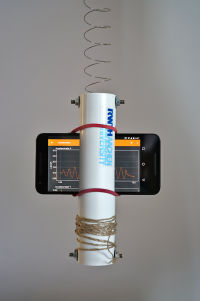Experiment: Spring
| Experiment | Spring |
|---|---|
| Category | Mechanics |
| Used sensors | Acceleration (without g) |
The experiment "Spring" tracks the movement of a spring pendulum and determines its period and frequency.
(This experiment is quite similar to the Experiment: Pendulum, which is used for a pendulum attached to a string.)
Contents
Requirements
You need a spring and a mount for your phone, so you can attach it to the spring. A simple mount can be made from a small paper roll like the inner part of a toilet paper roll, a rubber band and a screw.
Also, a second device as a remote control for the experiment is advisable.
Setup
Mount
The mount in the picture to the right is made from a plastic tube, but the principle can be applied to a paper tube (for example from toilet paper) as well. Cut out an oblong hole on each side of the tube, so you can stick your phone through it. Put a screw into the top of the tube, so you can attach the spring here. Finally secure your phone with a rubber band.
The string in the bottom part of the picture is used for the pendulum experiment. The second screw at the bottom has the same function as the one at the top.
Experiment
Open the "spring" experiment in phyphox and setup the remote access to your second device (alternatively, you may work with timed experiments, but the buttons on your phone may be hard to reach in the mount). Place the phone in the mount and make sure that it is secured with the rubber band (really, make sure it is properly attached - you don't want to drop your phone!).
Attach the mount to the spring and let it oscillate. The best way to do this is by pulling down the phone a little and let it go. This way you avoid that the phone hits the floor - just do not move it down so much that it overshoots... Finally, while already oscillating, start the experiment to determine the oscillation frequency and period.
Analysis
phyphox will record the acceleration of your phone during the experiment. It should follow a sine function with the extreme values (maximum absolute acceleration) at the highest and lowest point of the oscillation movement.
To determine the period of this oscillation, phyphox calculates the autocorrelation of the data. The first maximum (after the maximum at zero) is taken as the period and its inverse as the oscillation frequency.
Problems and resolutions
- High-frequency oscillations on top of the actual spring oscillation. This may happen if the phone "wobbles" about other axes. The sensor picks up all acceleration, so try to start the oscillation without rotating the phone. Moving it down a little (you do not necessarily need strong movement) and letting go is a good way to achieve a smooth oscillation.
